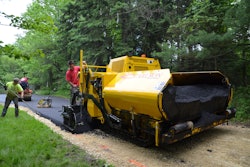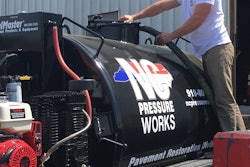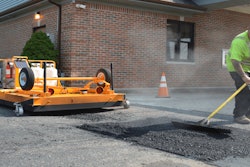
When a “subcontractor specialist,” such as a striping, repair or paving contractor, is under the leadership and contracted to work for a General Contractor, the smart Foreman realizes that the relationship he establishes with the project’s senior field leader needs to be positive and proactive.
In this article I’d like to address how a Crew Foreman, representing a subcontractor specialist, can project a positive presence and be proactive in connecting with their Project Superintendent.
Positive in Presence
This is where first and lasting impressions are made. The subcontractor Foreman can actually have less experience or knowledge than the GC Superintendent would want, but if the Foreman’s attitude is upbeat, positive, and committed to the completion of their portion of the project, they will win many “indulgences” from the Superintendent. This same Superintendent, who is often irritable and negative, will often soften up for the Foreman who presents a positive and upbeat manner at the site.
Consider a few positive actions to win over the Superintendent:
- Introduce yourself to the Superintendent upon first arrival. Don’t wait for them to come find you; they hate tracking down field leaders.
- When you meet the Superintendent, shake their hand and look at them confidently. No handshake or the lack of eye contact signals weakness, being unprepared, and “I really don’t want to be here.”
- Make it a habit to start your arrival each day asking the Superintendent, “How’s it going?” and following that up with “Anything new developed?”
- Monday arrival should include the “look ahead” for that week of work. Most subcontractors are afraid to share their plan, but those who do provide a schedule make the Superintendent’s day.
- When someone brings a negative situation to you, adapt an attitude that includes, “OK, that doesn’t sound great but let’s give our best shot here and see what we can come up with to solve the issue.” Superintendents love the Foreman who sees problems as opportunities.
- Let the Superintendent be the first to know good news.
- Once in a while, bring donuts to a meeting.
- If your team is celebrating with a lunch, invite the Superintendent.
- Be sure to introduce the Superintendent to your workers when the opportunities arise.
- Drop by the Superintendent’s office on the way out every day. If he (or she) is there, make some small talk. Share what you completed and where you would like to start the next morning
Never miss an opportunity to make a good impression on your Superintendent – without becoming a stage actor. There will be enough opportunities for such good image making, just be patient.
Proactive in Connecting
Being positive is important but actually engaging the Superintendent requires an intentional effort. One that impresses the Superintendent that you have a focus, a plan, and want a relationship based on transparency and trust. Your proactive efforts to connect with the Superintendent will return huge favors and give you a reputation as their “preferred contractor.”
Consider a few proactive actions when connecting with the Superintendent:
- When giving the Superintendent your week’s schedule (aka, the Look-Ahead), be sure to point out what actions the Superintendent might take that would help you meet the schedule. This builds a little commitment from the Superintendent to you.
- Keep your Superintendent updated; this will make the Superintendent an early fan of yours. Most Foremen tend to avoid their jobsite Superintendent and that’s exactly the wrong thing to do.
- As part of updating, provide a mid-day report before lunch. Most Superintendents want to get an idea of where the productivity will be by 4:00 p.m. Make an extra effort to give your best estimate of where your crew will finish up the day.
- Make your crew’s work area the cleanest on the site.
- During weekly meetings be a good listener, take notes, and engage the discussion periodically. Offer to assist another contractor. Such an effort sends signals that you are a team player.
- Ask the Superintendent to come by and inspect some of the early efforts of your workers. Better to get the Superintendent’s thoughts on “good/not good” early. This effort also sends a signal to the Superintendent that you are not afraid of their presence or an honest assessment.
- Work to develop a daily “hi-lo” update for the Superintendent and deliver it verbally near the end of the day. Share two or three “High-lights” of the day and two or three “Low-lights” that need to be addressed.
- When a challenging issue arises, especially one that the Superintendent knows about, take the lead on trying to resolve the issue. Take up the challenge, letting the Superintendent know that you are “on it.”
- Place some simple “signage” in your work area that communicates where tools and materials are to be kept, organized etc. This is really a big deal for many Superintendents as they like to see organization from their contractors.
There are a host of other proactive efforts that you can take as a Field Leader when reporting to a GC Superintendent, but the primary focus should be that you are proactive about getting in, performing and promoting a quality and safe work site, and over-communicating your progress. If done, you will find even the most negative Superintendent cutting some slack for you and your crew.


![Lee Boy Facility 2025 17 Use[16]](https://img.forconstructionpros.com/mindful/acbm/workspaces/default/uploads/2025/09/leeboy-facility-2025-17-use16.AbONDzEzbV.jpg?auto=format%2Ccompress&fit=crop&h=100&q=70&w=100)







![Lee Boy Facility 2025 17 Use[16]](https://img.forconstructionpros.com/mindful/acbm/workspaces/default/uploads/2025/09/leeboy-facility-2025-17-use16.AbONDzEzbV.jpg?ar=16%3A9&auto=format%2Ccompress&fit=crop&h=135&q=70&w=240)









